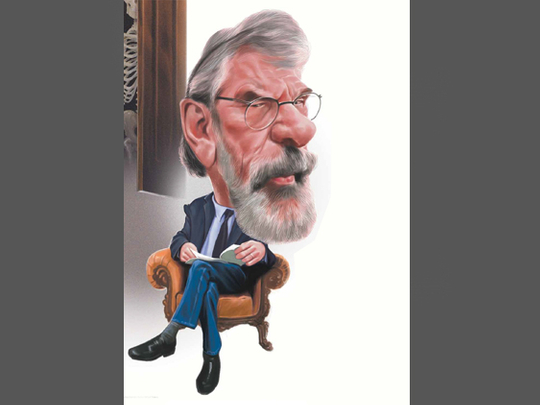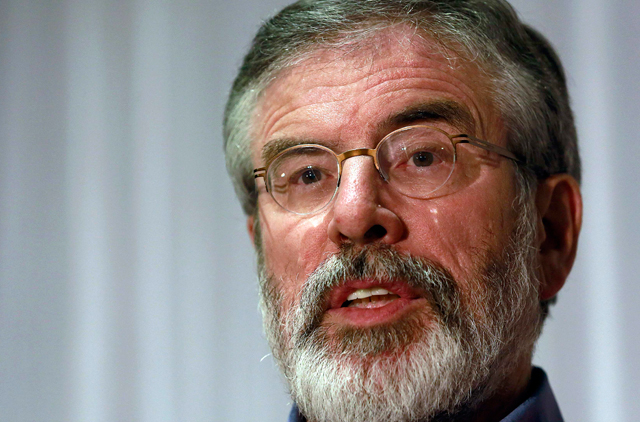
Ireland is a land of too little geography and too much history. Yet, for all of its small size, somewhere, in lonely bogs, beneath mountain bushes or on salty and sandy beaches, there are bodies buried — quickly interred in shallow graves by masked men with blood on their hands and the cause of a united island in their hearts.
While the world has embraced Sinn Fein president Gerry Adams as a man who persuaded his comrades in arms in the Provisional Irish Republican Army (IRA) to walk the path of peace, those buried in the unmarked places have come back to haunt him. On Wednesday, Adams turned himself into to the Police Service of Northern Ireland for questioning in the kidnapping and killings of Jean McConville in 1972.
At the time, Adams was described by others in the IRA as commander of the Belfast Brigade. As such, every use of a weapon — there were precious few in those days before the late Muammar Gaddafi obliged with a shipment or two from Libya — had to be sanctioned by the brigade’s leadership
. Every action in what the IRA believed to be a war against the British crown’s forces of occupation, had to be sanctioned by brigade command. And anyone in the local nationalist population of West Belfast who was perceived as being a threat, an opponent, or a collaborator, could only be dealt with on the orders of the brigade officers.
In the rush to peace, the brutal acts of war are often overlooked — pushed aside by those who broker political agreements, files shelved and shredded by police forces who have dark deeds to remain in the shadows, and best forgotten by those who took the screaming and struggling victims away, broke their bones with hammers, burnt their flesh with cigarettes and heard their last prayers or curses before a bullet ended their sobbed suffering as they crumpled over into a shallow grave.
There are those who benefit from peace — Adams is one, for years an absentee member of parliament at Westminster, now a member of Ireland’s parliament in Dublin. Now 65, an author of some talent, he wears the mantle of Irish Republican and democrat with ease. But that is a mantle too that has been well worn by Sinn Fein, the political wing of the IRA.
At no time has Adams ever acknowledged that he played an active part in the IRA — but there are others who served in it who say that he issued the orders in the Belfast Brigade — and they say it was he who had ordered Jean McConville, a widow and mother of 10 children — to be taken kicking and screaming from her home in the Divis Street Flats to be questioned and end her life on a beach grave across the border in the Irish Republic.
The Flats were the tallest building in Belfast. On the roof, the British Army built an observation post, supplied by helicopters because the stairwells were too dangerous. It was IRA territory, used by it to snipe at army patrols. And anyone who lived there — widow, mother or children alike — were under the Belfast Brigade’s war watch.
Restless sleep
After her disappearance, the IRA put out a story that she had abandoned her 10 children. It took another 26 years before the IRA admitted they killed her. Adams himself is one of ten children, growing up in a home where physical and sexual violence was no stranger. He was also a barman in the Duke of York, blown up by the IRA and now a popular watering hole in a city that has boomed in peace.
IRA officer Brendan Hughes made no secret of his role in the troubled times on the 1970s and 1980s. In the interests of history and, being able to sleep a restless sleep of those with blood on their hands, Hughes recorded his involvement to the Boston College Belfast Project.
So too did dozens of others, under the proviso that the tapes remain sealed until after death. He died in 2008 — Adams followed Republican protocol and helped carry his coffin — and Hughes’ tapes contain an allegation that Adams was a senior Belfast Brigade IRA leader and had ordered McConville’s killing. They are claims that the Sinn Fein leader vehemently contests.
Prior to her death last year, Old Bailey bomber Dolours Price made further allegations separate to the Boston College project, saying Adams gave the orders — and again he rejected the claims. Before he walked into the police station in Belfast on Wednesday, Adams also rejected recent claims by former IRA bomber and convicted killer Peter Rogers that he and the Sinn Fein deputy first minister Martin McGuinness had ordered him to transport explosives to bomb Britain in 1980.
Ivor Bell is another former IRA Belfast commander who points the finger at Adams. Given the IRA’s attitude to those who betray it, Bell can count himself lucky to be alive — he tried to organise a coup within its ranks and is now a sworn enemy to Adams. But Bell has been charged three months in the McConville kidnapping and killing. And if the case against Adams progresses to charges, Bell will have a role to play in those proceedings — either as a witness or as a co-conspirator.
There are seven ‘disappeared’ who lie in shallow graves without the rest of peace. Jean McConville was one of the ‘lucky’ ones — a man walking his dog on a beach found her broken and bulleted skull in 2003. How long more before those masked men with blood on their hands will rest peacefully each night now?











